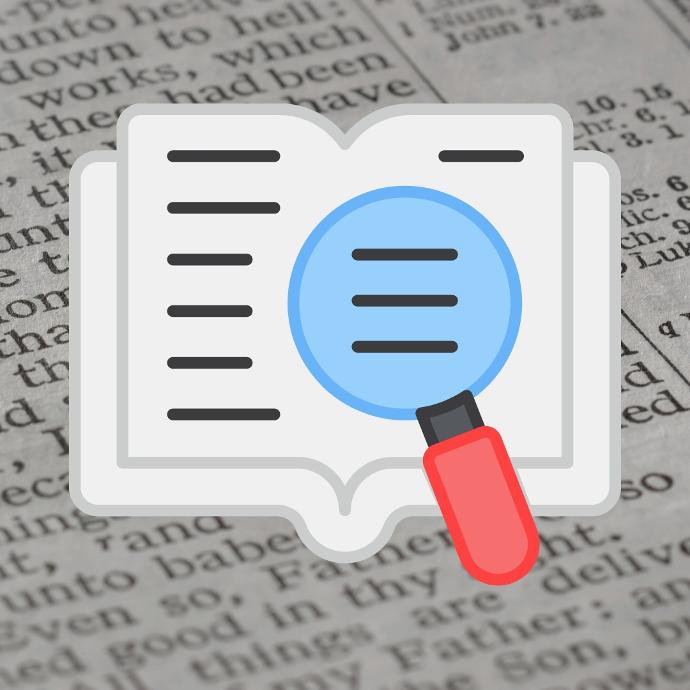2 And I saw the seven angels who stood before God; and to them were given seven trumpets.
3 And another angel came and stood at the altar, having a golden censer; and there was given unto him much incense, that he should offer it with the prayers of all saints upon the golden altar which was before the throne.
4 And the smoke of the incense, which came with the prayers of the saints, ascended up before God out of the angel's hand.
5 And the angel took the censer, and filled it with fire from the altar, and cast it into the earth: and there were voices, and thunderings, and lightnings, and an earthquake.
6 And the seven angels who had the seven trumpets prepared themselves to sound.
Drawing Connections
In study #50, we talked about how the Seven Trumpets describes events occurring during the same time portrayed by the Seven Churches and the Seven Seals. This is the period from John’s time, right after Jesus’ death and resurrection, all the way to His Second Coming. But how can we be sure of this, if the Bible text from the Seventh Seal continues on from Revelation 8:1 right on, apparently seamlessly into verse 2 to 6?
Let's recall where John was during this vision. He remained in the throne room throughout the opening of the seven seals, witnessing the events that unfolded on Earth with each seal Jesus opened. Once the part of the vision related to the seals was complete, John observed a new activity beginning, still taking place in the throne room. We know this because verse 2 tells us that the angels were standing before God when they received their trumpets.
In today's study, we will explore the introduction to the Seven Trumpets and allow the Bible to reveal the prophetic period they cover. We will also examine the elements of the Sanctuary that appear in the text.
Closer Look
*** The timing of the trumpets ***: Without careful examination, one could think that the scene preceding the Seven Trumpets occur immediately after the end of the Seven Seals, after Christ's return. But, we need to remember something very important. When the Bible was written, it had no chapters, verses, or section titles. These markings and divisions came with the translations, to help people find texts and navigate throughout the Bible. Many translations place verse 2-6 inside the Seventh Seal. However, when we study the text closely, we can see that verses 2-6 of chapter 8 refer to the opening scene where the trumpets are introduced.
If the Seven Trumpets cover the same period of the Churches and the Seals, then we need to see if the Seven Trumpets end around the time of Christ's Second Coming. And that is exactly what we find in Revelation 11:15: "And the seventh angel sounded; and there were great voices in heaven, saying, The kingdom of this world has become the kingdom of our Lord, and of his Christ; and he shall reign forever and ever." Revelation 10:7 says: "But in the days of the voice of the seventh angel, when he shall begin to sound, the mystery of God should be finished, as he has declared to his servants the prophets." God's rescue plan for humanity will be revealed in full force at Jesus' Second Coming, and His kingdom will be complete, ready for His eternal reign.
We've now seen how the Trumpets end with the events of the Second Coming. Lets now understand how they begin. The introduction section in Revelation 8:2-6 is the text that explains exactly that. These five verses function like the scene of the glorified Christ in Revelation 1, and the enthronement party in Revelation 4 and 5. They each gave a foundation to their following sections. It would be very difficult to understand the importance of the Seven Churches without chapter 1, or to understand the meaning of the Seven Seals without chapters 4 and 5 of Revelation.
*** Seven angels with seven trumpets ***: At this point, it is clear that the number 7 is significant. We have been studying the meaning of the number 7 with every topic of Revelation so far. Seven functions like an adjective, qualifying the subject that comes after it. It gives that subject an identity of fullness, completeness, and perfection. In Revelation 8:2 John saw seven angels. But they weren't any seven angels. They were 'the' seven angels. These specific seven angels were not described in the throne scene in Revelation 4 and 5, but the fact that they are here identified as 'the' seven angels makes us believe they are a very special order of angels. It is possible that these are the same seven angels who pour out the seven last plagues in Revelation 15 and 16. Revelation 8:2 says the seven angels stand before God. Luke 1:19 talks about Gabriel, who stands in the presence of God. We really don't now who exactly are these angels, or if Gabriel is one of them. The important thing is that they are ready to serve God, as they stand in His presence. They each receive a trumpet. God is evidently the highest authority in verse 2, and since the angels receive the trumpets while in God's presence, we can understand that God is the one in charge of giving the trumpets and consequently in charge of giving the order to sound them. Everything is under God's control.
*** Another angel, and 2 altars ***: If we don’t read Revelation 8:3 carefully, we will not be able to understand what it is really saying. We need to pay close attention to the small details. After the seven angels received the trumpets, John saw another angel. Some translations say this other angel stood at the altar. The word translated as "at" is the Greek word epi, which means "on" or "upon". Why is the angel standing on the altar? and which altar is this? Let’s look back at the Old Testament tabernacle, because this passage is a direct reference to temple services. The end of verse 3 mentions a second altar: the one that is before the throne, which is the altar of incense. The altar of incense was inside the first chamber of the tabernacle, and the only thing separating it from the arc of the covenant (which represented the throne of God) was the veil (Exodus 30:6-7). But the first altar mentioned in the beginning of the verse is not specified. If they were the same altar, John most likely would have stated that the first one was the altar of incense, and just referred to it the second time as ‘altar’. But the way he actually wrote the text, he only specified the second one, and not the first. The fact that the angel is standing on the first altar is a big clue. When we studied the fifth seal (study #42), we saw the saints who were praying under the altar of burnt offerings, in the courtyard (Revelation 6:9,10). And now, in Revelation 8:3, we see an angel standing on that altar, and he is supposed to take the prayers of the saints from the burnt altar in the courtyard to the altar of incense located inside, before the throne of God.
After the Israelites returned from the exile in Babylon, God gave the prophet new measurements for the altar of burnt offerings. We read in Ezekiel 43:13-17 that the altar of burnt offerings was a very large structure. In order to get to the sacrifice, the priest had to climb a set of stairs, and he would stand at the top of the altar. The altar of incense was a much smaller piece of furniture, inside the first chamber (Exodus 30:1-10; Exodus 37:25-29). All the Jewish tradition, which was the teaching of the Oral Torah, was saved for posterity in written form. This rabbinic work is known as Mishnah. According to the Mishnah, the altar of burnt offerings, possibly in John’s time, was even larger than that. The statement about the angel standing on the altar would have made the first century reader immediately identify the first altar as the altar of burnt offerings.
Altar Measurements
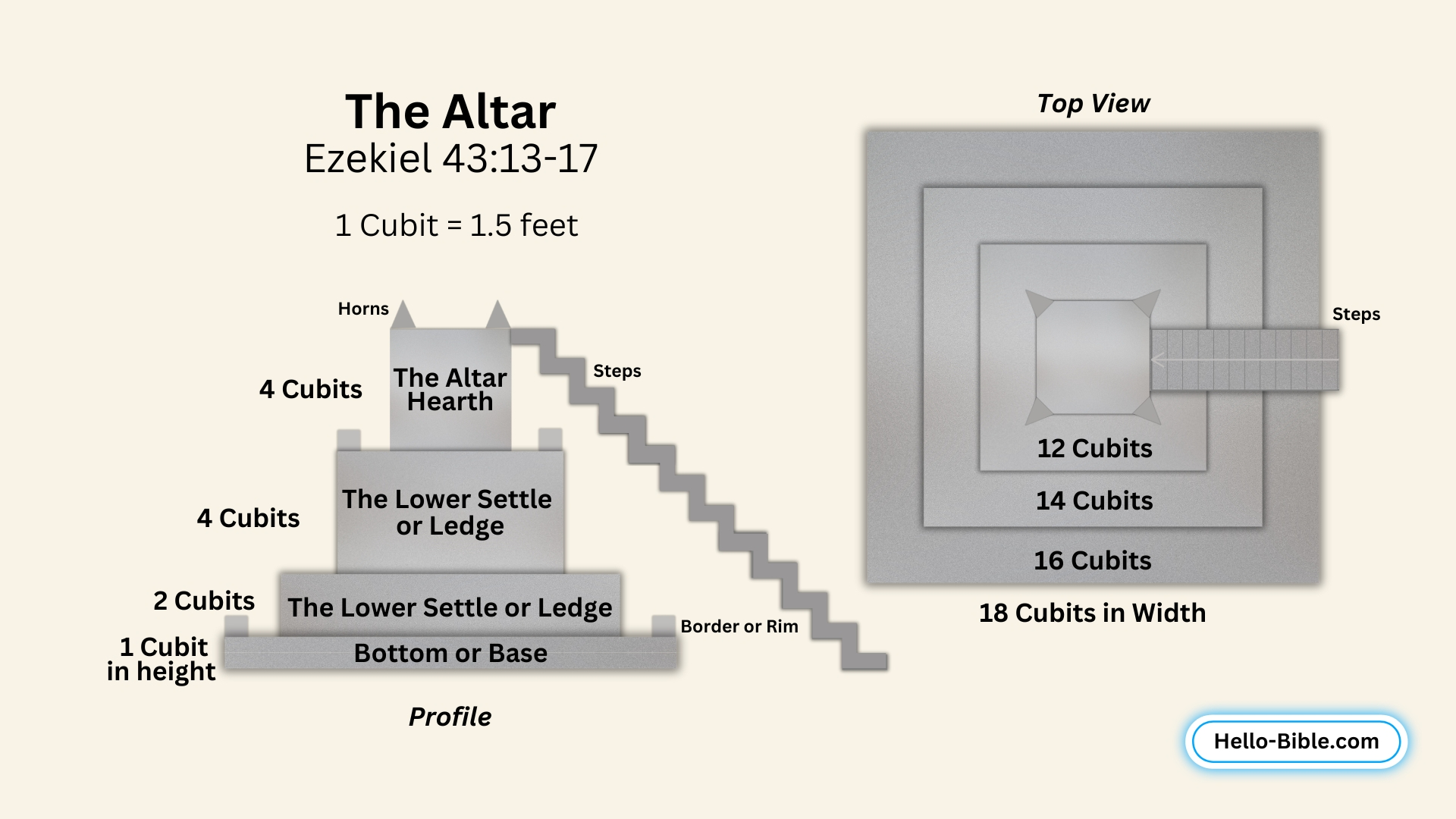
© Hello-Bible - 2024
Medidas do Altar
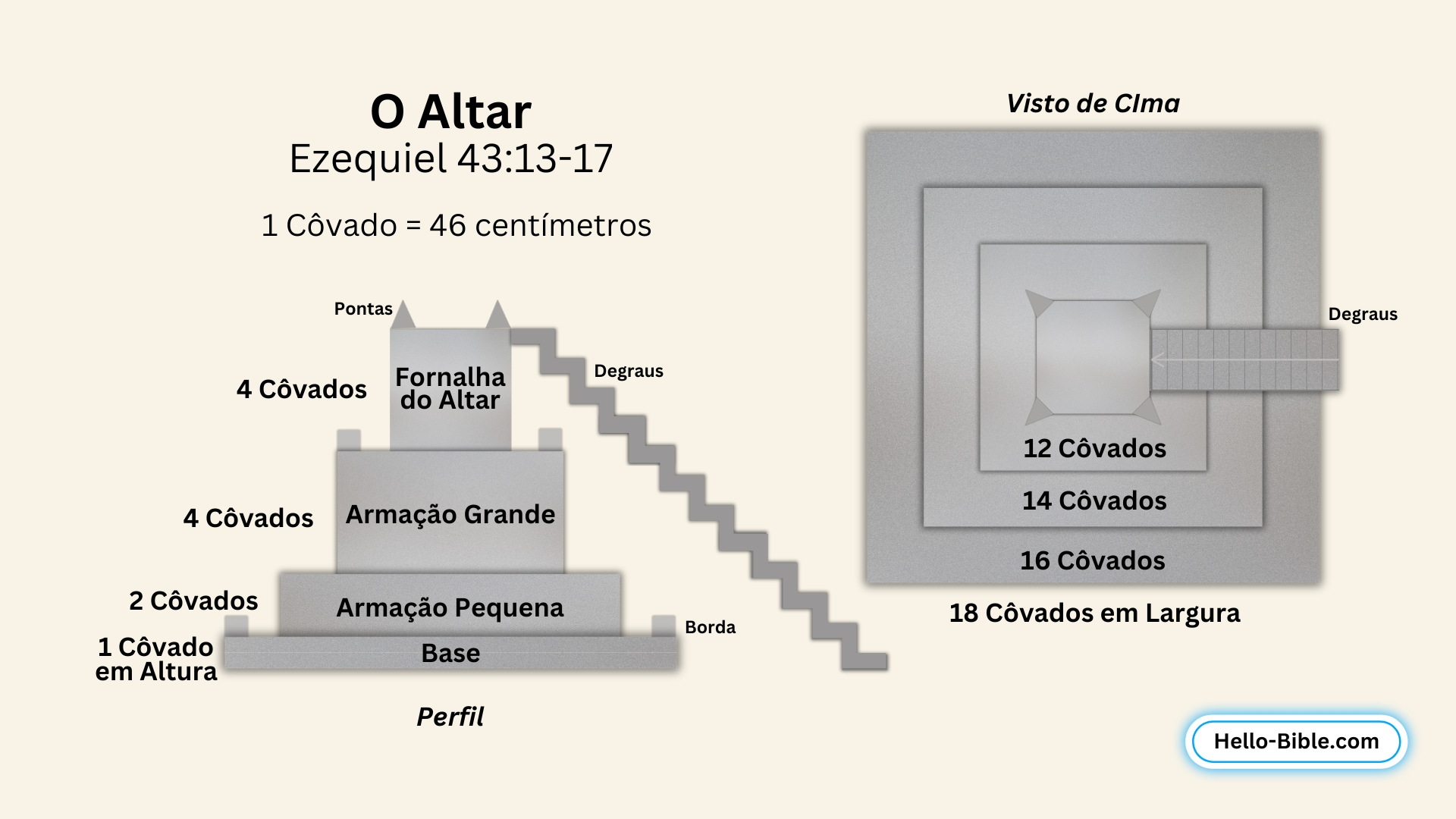
© Hello-Bible - 2024
The altar in Moses's time was a smaller piece, but the one John grew up with and got to see in use in the temple up to Jesus' death was a much larger one, where the priests walking or standing on the altar was a normal and expected part of the ceremony.
Altar of Burnt Offerings
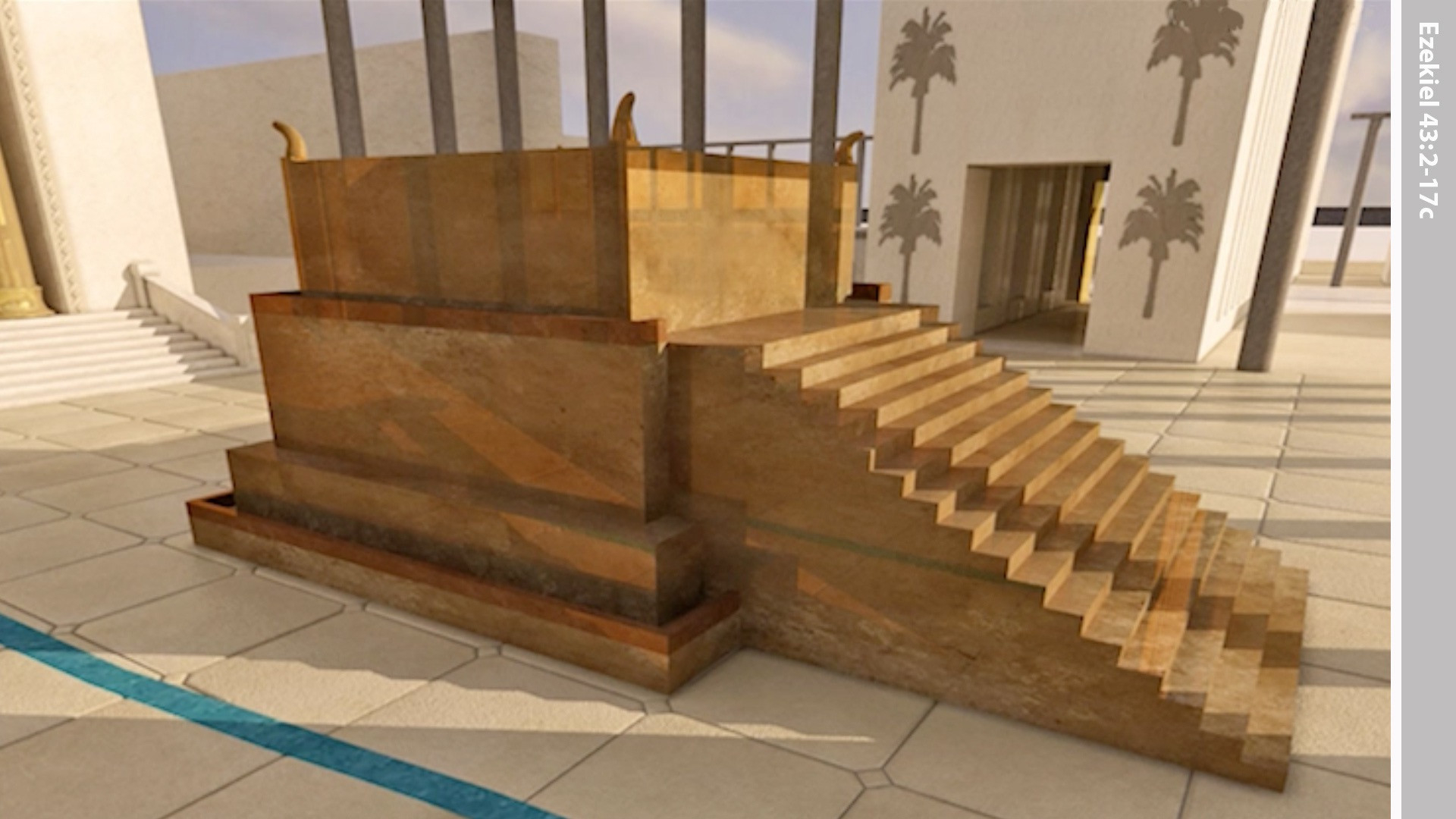
Attribution: bibliaprints.com at freebibleimages.org
*** The smoke of incense and the prayers of the saints ***: According to the Mishnah, during the daily sacrificial rituals, one of the priests had to bring coals from the altar of burnt offerings and also three measures of incense to the Holy Place. He would then spread the coals on the altar of incense, and then pour the incense powder over the lit coals. The incense would burn immediately, and the smoke would start to fill the room. In a similar way, Revelation 8:3 tells us that the angel with the golden censer had received much incense, and he had to bring the prayers of the saints who were under the altar and present them to God. The saints were praying for God to pour His judgement on those “who dwell on the Earth” (Revelation 6:10). We read that the angel brought the prayers of the saints to the altar of incense, and offered them to God, just as the priest was supposed to do in the Old Testament (Exodus 30:7-8). In Psalm 141:1-2, David wished for His cry to be set forth before the Lord like incense. And that is the idea in this passage of Revelation. Revelation 8:4 tells us that God heard the prayers of the saints, symbolized by the smoke of incense that had ascended to God.
Altar of Incense
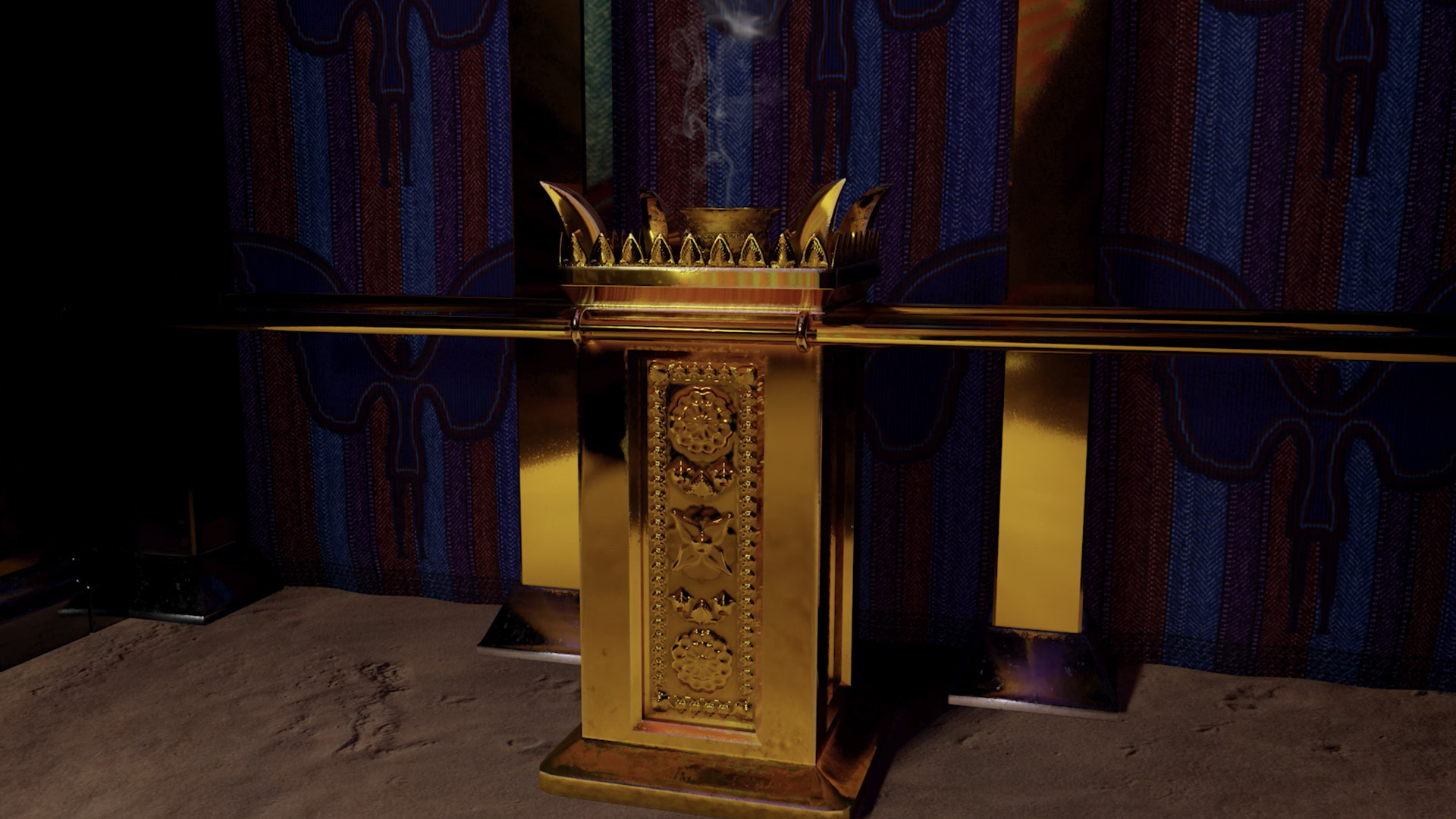
Attribution: Jeremy Park, Bible-Scenes.com
*** Casting the censer on to the Earth ***: Before the angel cast his censer onto the Earth, he filled it with fire from the altar of incense. This reminds us of when Moses asked Aaron to fill his censer with fire from the altar of incense, fill his censer with incense, and go to the congregation quickly to make atonement for the Israelites - the wrath of God had gone out (Numbers 16:46). The Bible does not tell us that Aaron threw his censer on the ground. But another passage talks about coals that were scattered over Jerusalem because of the abominations of the people (Ezekiel 10:1-2). David said: “Let burning coals fall upon [the wicked]: let them be cast into the fire; into deep pits, that they rise not up again” (Psalm 140:10); and “Upon the wicked he shall rain snares, fire and brimstone, and a horrible tempest: this shall be the portion of their cup.” (Psalm 11:6). In the vision, John saw that fire from the censer was poured on the Earth, as a measure of God’s judgement. Interestingly enough, the fire from the censer, came from the altar where the prayers of the saints were offered. The throwing of the censer filled with fire on the Earth meant that God had not only heard the prayers of the saints, but was also taking an active role in responding to their request. John once again described God’s presence by stating “there were voices, and thunderings, and lightnings, and an earthquake.” (Revelation 8:5). When we see these elements, thunder, lightening, and earthquakes, we can expect that God is about to say or do something important. God appeared in a thick cloud to speak to Moses on Mount Sinai, and the cloud was accompanied by lightning, thunder, and loud trumpet that made people tremble (Exodus 19:8 [the people could hear God speak], 19:16). Right before God received Christ on to His right side, John said that out of God’s throne, “proceeded lightning and thunderings and voices” (Revelation 4:5). Psalm 29:3-4 says that “the God of glory thunders”, and that “the voice of the LORD is powerful; the voice of the LORD is full of majesty.”
*** The seven angels prepared to sound the trumpet ***: In the temple’s daily ceremony, after the sacrificial animal was consumed by fire, the priest was to pour wine over the altar of burnt sacrifices (Exodus 29:38-44; Numbers 28:1-8). According to the Mishnah, right before the priest who was at the top of the altar poured the wine on the sacrifice, the priests who were in charge of the trumpets were to sound their horns as a warning to the people. Everyone was to pay attention to what was about to take place. It is important to note that the trumpet is played right after the lamb is consumed by the fire, at the end of the sacrificial portion of the daily routine. This helps us put together the starting point of the time frame for the Seven trumpets. The Seven Trumpets start right after Christ’s death, as the Lamb who was slain. Revelation 8:6 says that the seven angels prepared themselves to sound their trumpets. God was about to reveal something important.
Overview
In order to understand the scene that precedes the sounding of the trumpets, we need to understand the daily ceremonial rituals of the Israelites. John makes a strong use of temple service imagery to describe what is happening in the vision. The sounding of the trumpets are the answer to the prayers of the saints brought before the Lord. God has been answering these prayers ever since Jesus' death at the cross. And His final trumpet answer will come with the last trumpet, on the Day of the Lord, when Jesus returns. Now that we understand that God’s judgements on the ones who turn their backs to the Lord have started in John’s time, we can see that during most of the time of the Trumpets, there is still a chance for the people of the Earth to repent, and turn to God. But their time is limited, and they must listen to the alarm. God is merciful, and He is sending His warning, encouraging everyone to make their decision in favor or against accepting the sacrifice Christ made for us. It is still not too late to make the right choice.
